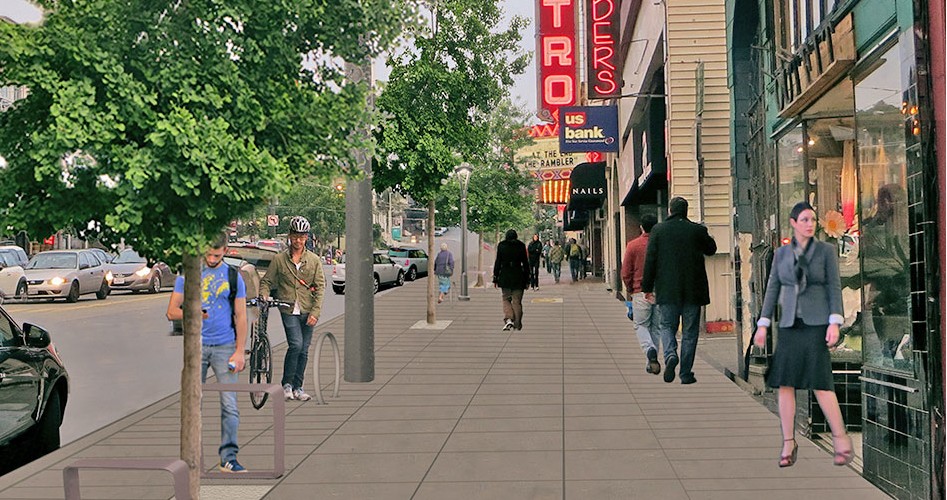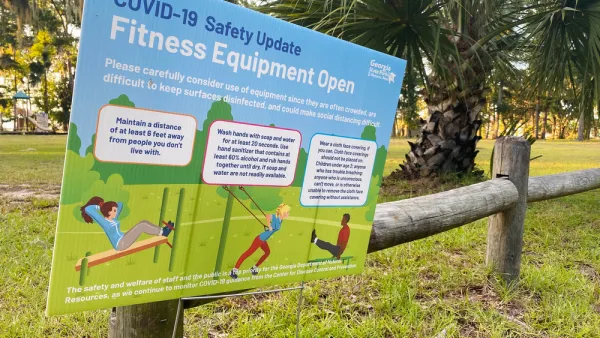A new study based on an analysis of the residents of Turin, Italy, a city of over 900,000, reveals that walkable access to public transit and urban services benefits mental health, particularly for women and seniors.

Last weekend I was enjoying a coffee at the outdoor seating of Castro Coffee on the widened Castro Street in San Francisco.
Credit: Castro Street Improvement Project
An elderly Asian women asked if she could join me due to the limited seating, and we soon struck up some small talk. She lived nearby in her 47-year-old son's home, and she told me of all the transit—bus, light rail, and streetcar lines near her home, particularly which ones took her to Japantown. She called the buses her "limousines" because they would drop her off right in front of her home.
Along comes this study published in the International Journal of Environmental Research and Public Health that completely validates everything she said. Access to multiple transit lines and living within walking distance to a vibrant business district appears to be contributing to this senior's mental (as well as physical) health.
"For the study, a group of Italy-based researchers gathered long-term data on Turin residents," writes Eric Jaffe, CityLab’s New York bureau chief...."Of the environmental factors, density and transit access proved “protective” of mental health, especially for women (of all ages) and older people (age 50 to 64)."
These populations were prescribed fewer antidepressant drugs when they lived in places reached more quickly by bus or train, in places with taller average building heights, compared with counterparts in more remote or sparse areas. That connection held up even when social factors were taken into account.
A look through Planetizen posts tagged 'mental health' shows no lack of articles showing a nexus with green spaces or trees, yet the Turin study showed no such connection "between mental health and public green space," writes Jaffe. "That’s surprising considering the vast evidence supporting this link." [See 'related' below.]
Conclusion from the study's abstract:
Therefore, this research suggests that good accessibility to public transport, as well as a dense urban structure (versus sprawl), could contribute to reduced risk of depression, especially for women and elderly, by increasing opportunities to move around and have an active social life.
Hat tip to Metro Transportation Library.
FULL STORY: Living Near a Transit Line Might Be Good for Your Mental Health

Analysis: Cybertruck Fatality Rate Far Exceeds That of Ford Pinto
The Tesla Cybertruck was recalled seven times last year.

National Parks Layoffs Will Cause Communities to Lose Billions
Thousands of essential park workers were laid off this week, just before the busy spring break season.

Retro-silient?: America’s First “Eco-burb,” The Woodlands Turns 50
A master-planned community north of Houston offers lessons on green infrastructure and resilient design, but falls short of its founder’s lofty affordability and walkability goals.

Test News Post 1
This is a summary

Analysis: Cybertruck Fatality Rate Far Exceeds That of Ford Pinto
The Tesla Cybertruck was recalled seven times last year.

Test News Headline 46
Test for the image on the front page.
Urban Design for Planners 1: Software Tools
This six-course series explores essential urban design concepts using open source software and equips planners with the tools they need to participate fully in the urban design process.
Planning for Universal Design
Learn the tools for implementing Universal Design in planning regulations.
EMC Planning Group, Inc.
Planetizen
Planetizen
Mpact (formerly Rail~Volution)
Great Falls Development Authority, Inc.
HUDs Office of Policy Development and Research
NYU Wagner Graduate School of Public Service




























